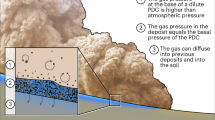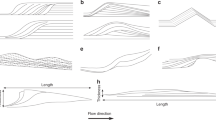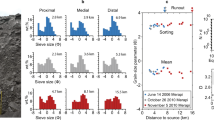Abstract
At 8.32 a.m. on 18 May 1980, failure of the upper part of the north slope of Mount St Helens triggered a lateral eruption (‘the blast’) that devastated the conifer forests in a sector covering ∼500 km2 north of the volcano. I present here a steady flow model for the blast dynamics and propose that through much of the devastated area the blast was a supersonic flow of a complex multiphase (solid, liquid, vapour) mixture. The shape of the blast zone; pressure, temperature, velocity (Mach number) and density distributions within the flow; positions of weak and strong internal shocks; and mass flux, energy flux, and total energy are calculated. The shape of blast zone was determined by the initial areal expansion from the reservoir, by internal expansion and compression waves (including shocks), and by the density of the expanding mixture. The pressure within the flow dropped rapidly away from the source of the blast until, at a distance of ∼11 km, the flow became underpressured relative to the surrounding atmosphere. Weak shocks within the flow subparallel to the east and west margins coalesced at about this distance into a strong Mach disk shock, across which the flow velocities would have dropped from supersonic to subsonic as the pressure rose back towards ambient. The positions of the shocks may be reflected in differences in the patterns of felled trees. At the limits of the devastated area, the temperature had dropped only 20% from the reservoir temperature because the entrained solids thermally buffered the flow (the dynamic and thermodynamic effects of the admixture of the surrounding atmosphere and the uprooted forest and soils into the flow are not considered). The density of the flow decreased with distance until, at the limits of the blast zone, 20–25 km from the volcano, the density became comparable with that of the surrounding (dirty) atmosphere and the flow became buoyant and ramped up into the atmosphere. According to the model, the mass flux per unit area at the source was 0.6 × 104 g s−1 cm−2 and the energy flux per unit area was 2.5 MW cm−2. From the measured total ejected mass, 0.25 × 1015 g, the total energy released during the eruption was 1024 erg or 24 megatons. The model, triggering of the eruption and the transition from unsteady to steady flow, and applications to eyewitness observations and atmospheric effects are discussed in ref. 1.
This is a preview of subscription content, access via your institution
Access options
Subscribe to this journal
Receive 51 print issues and online access
$199.00 per year
only $3.90 per issue
Buy this article
- Purchase on Springer Link
- Instant access to full article PDF
Prices may be subject to local taxes which are calculated during checkout
Similar content being viewed by others
References
Kieffer, S. W. U.S. geol. Surv. Prof. Pap. 1250 (in the press).
Moore, J. G. & Albee, W. C. U.S. geol. Surv. Prof. Pap. 1250 (in the press).
Wallis, G. B. One-dimensional Two-phase Flow (McGraw Hill, New York, (1972).
JANNAF (Joint Army, Navy, NASA, Air Force) Handbook of Rocket Exhaust Plume Technology, Ch.2 (CPIA Publ. 263, 1975).
Author information
Authors and Affiliations
Rights and permissions
About this article
Cite this article
Kieffer, S. Blast dynamics at Mount St Helens on 18 May 1980. Nature 291, 568–570 (1981). https://doi.org/10.1038/291568a0
Received:
Accepted:
Issue Date:
DOI: https://doi.org/10.1038/291568a0
This article is cited by
-
Simulation study of atmosphere–ionosphere variations driven by the eruption of Hunga Tonga-Hunga Ha’apai on 15 January 2022
Earth, Planets and Space (2024)
-
Lateral edifice collapse and volcanic debris avalanches: a post-1980 Mount St. Helens perspective
Bulletin of Volcanology (2023)
-
A review of common natural disasters as analogs for asteroid impact effects and cascading hazards
Natural Hazards (2023)
-
Analog field-scale acoustic study of volcanic eruption directivity using a tiltable liquid nitrogen-charged water cannon
Earth, Planets and Space (2022)
-
The influence of magnetic and gravitational fields in a non-ideal dusty gas with heat conduction and radiation heat flux
Indian Journal of Physics (2022)
Comments
By submitting a comment you agree to abide by our Terms and Community Guidelines. If you find something abusive or that does not comply with our terms or guidelines please flag it as inappropriate.



